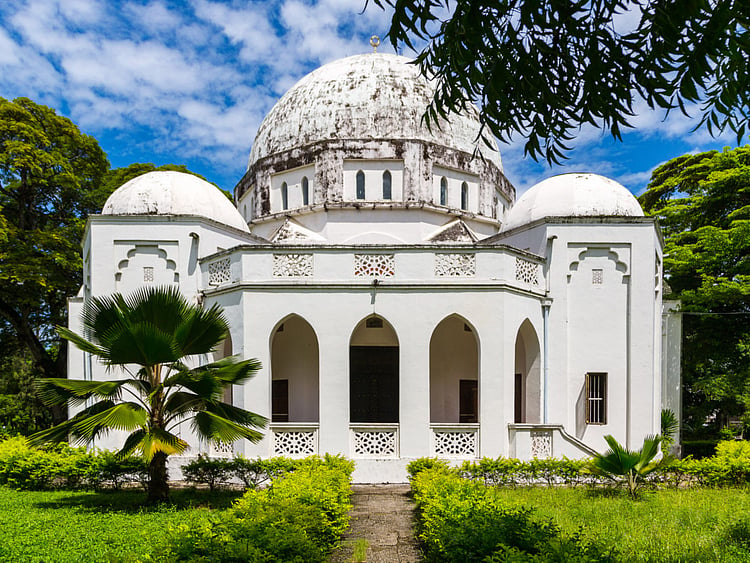Dubai: It is a little known fact that one of the present-day Gulf states was once a significant empire, the likes of which even the then superpowers, Portugal and Britain, found difficult to confront. The Omani Sultanate was a major maritime force from 17th to 19th centuries, and established its dominance in the Indian Ocean sea routes by defeating the mighty Portuguese navy.
Oman’s empire encompassed vast strips of southwest Iran, most of the north-eastern and southern parts of the Arabian peninsula, and much of the Horn of Africa coast, all the way down till northern Mozambique. And nowhere are the remnants of the empire more apparent than in Zanzibar.Ngome Kongwe, Old Fort, Stone Town, Zanzibar.
The history of Zanzibar is intrinsically linked to Oman, which ended the Portuguese dominance of the Indian Ocean trade routes once and for all after capturing their base, Fort Jesus, in Mombasa (in present-day Kenya), in 1698. It then set its sights on nearby Zanzibar, building the Old Fort in present-day Stone Town in the early 1710s to defend the island. Sayyid Said Bin Sultan Al Bu Said took power in Muscat in 1806 as the Sultan of Oman. When, in 1828, he first visited Zanzibar, he was captivated by the charm of the islands – and the potential profits to be made in the spice trade. In 1840 he moved his capital from Muscat to Zanzibar. Unlike the Dutch in their Far East colonies, Sultan Said encouraged everyone in Zanzibar to grow cloves, even threatening to confiscate their properties if they failed to do so. For centuries, its abundant and varied spices placed Zanzibar – also called the ‘Spice Island’ – at the centre of the profitable spice trade between countries and regions bordering the Indian Ocean.
Ties that bind
In Oman today, it is common to come across people who can trace their ancestry to Zanzibar, which is an archipelago of semi-autonomous islands and a part of Tanzania. Similarly, there is a preponderance of people of Omani origin, and Omani food, architecture, and customs, even today in Zanzibar. Oman’s national airline was one of the first to have direct flights to Stone Town, the capital of Zanzibar, as opposed to most other airlines than first land in Dar Es Salam, Tanzania’s capital before connecting to the archipelago. People from Zanzibar who can prove their Omani ancestry are entitled to Omani passports and citizenship. Although Islam accounts for about 40% of the 55 million population of mainland Tanzania, almost all of Zanzibar’s 1.3 million people are Muslims.
Zanzibaris are mainly of African origin, but with huge numbers of people of Omani, Indian, and Iranian descent. Years of living together on an isolated island has led to the emergence of a version of Swahili culture that is unique to Zanzibar. One famous Zanzibari was the Indian origin Farukh Bulsara, known to the rest of the world as Freddie Mercury.
One of the dark realities of the history of Zanzibar was the African slave trade. Under mounting pressure from the British, Sultan Said agreed to end the slave trade in 1847; Britain had earlier banned the trade in its colonies it following the Slavery Abolition Act of 1833. Though he spent much of his time in Zanzibar, Sultan Said visited Oman frequently. It was on one of his return journeys to Zanzibar that he died at sea, near Seychelles, in 1856. A succession battle soon ensued. By 1862, Zanzibar and Oman had become separate sultanates, each ruled by a son of Sultan Said.
Shortest war in history
By the late 1800s, the Omani empire was in decline, and the sultans in Zanzibar were increasingly coming under British tutelage. At 9.02am on August 27, 1896, the Anglo-Zanzibar War broke out. The cause of the war was the death of the pro-British Sultan Hamad Bin Thuwaini and the succession by Sultan Khalid Bin Barghash, who was not favoured by the Crown. British naval forces engaged in sustained bombardment of the sultan’s palace, the Bait Al Hukum, leaving 500 Zanzibaris dead or wounded. The Zanzibari resistance collapsed at exactly 9.40am. Sultan Khalid fled to the German consulate and then on to German East Africa (present-day mainland Tanzania) and was replaced by a British puppet. The Anglo-Zanzibar War, thereby, officially became the shortest war in the history of the world, lasting 38 minutes. In 1890, the British empire made Zanzibar its protectorate, seriously undermining the authority of the sultan in the decades that followed.
In 1963 the Zanzibar sultanate became a member of the British Commonwealth. In January 1964 a revolt by left-wing African activists overthrew the sultanate and established a republic. This was also a time of widespread anti-Arab and anti-Asian riots that left thousands dead. In April, Zanzibar and mainland Tanganyika decided to unite, leading to the emergence of Tanzania that same year.
Sign up for the Daily Briefing
Get the latest news and updates straight to your inbox
Network Links
GN StoreDownload our app
© Al Nisr Publishing LLC 2025. All rights reserved.
